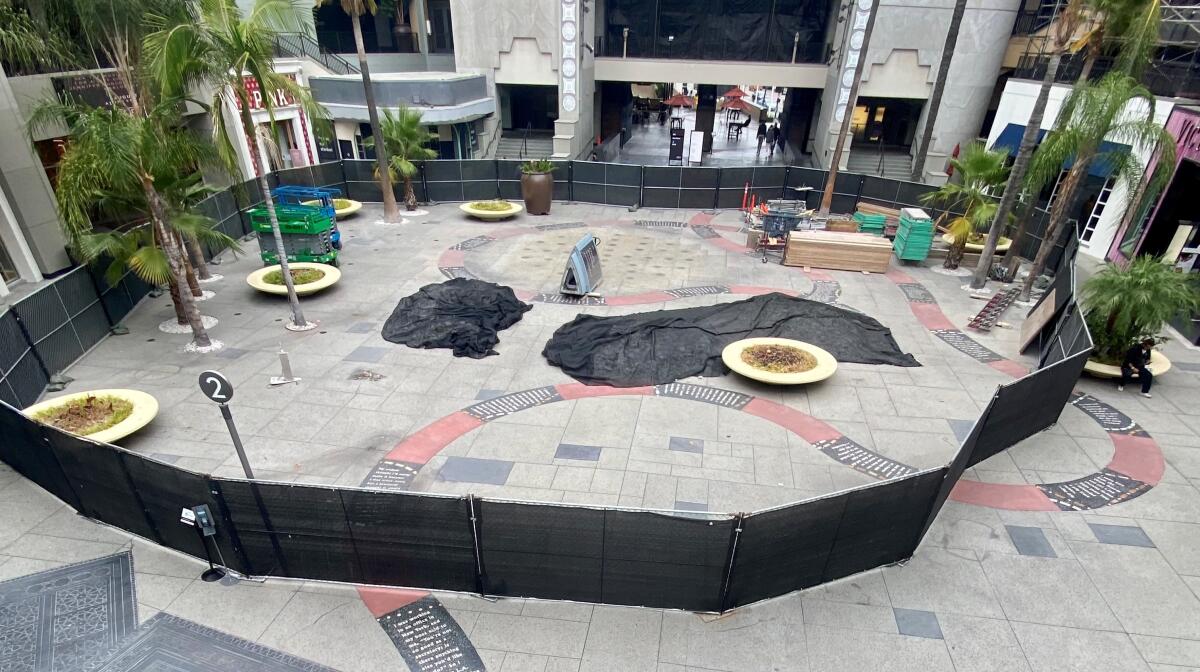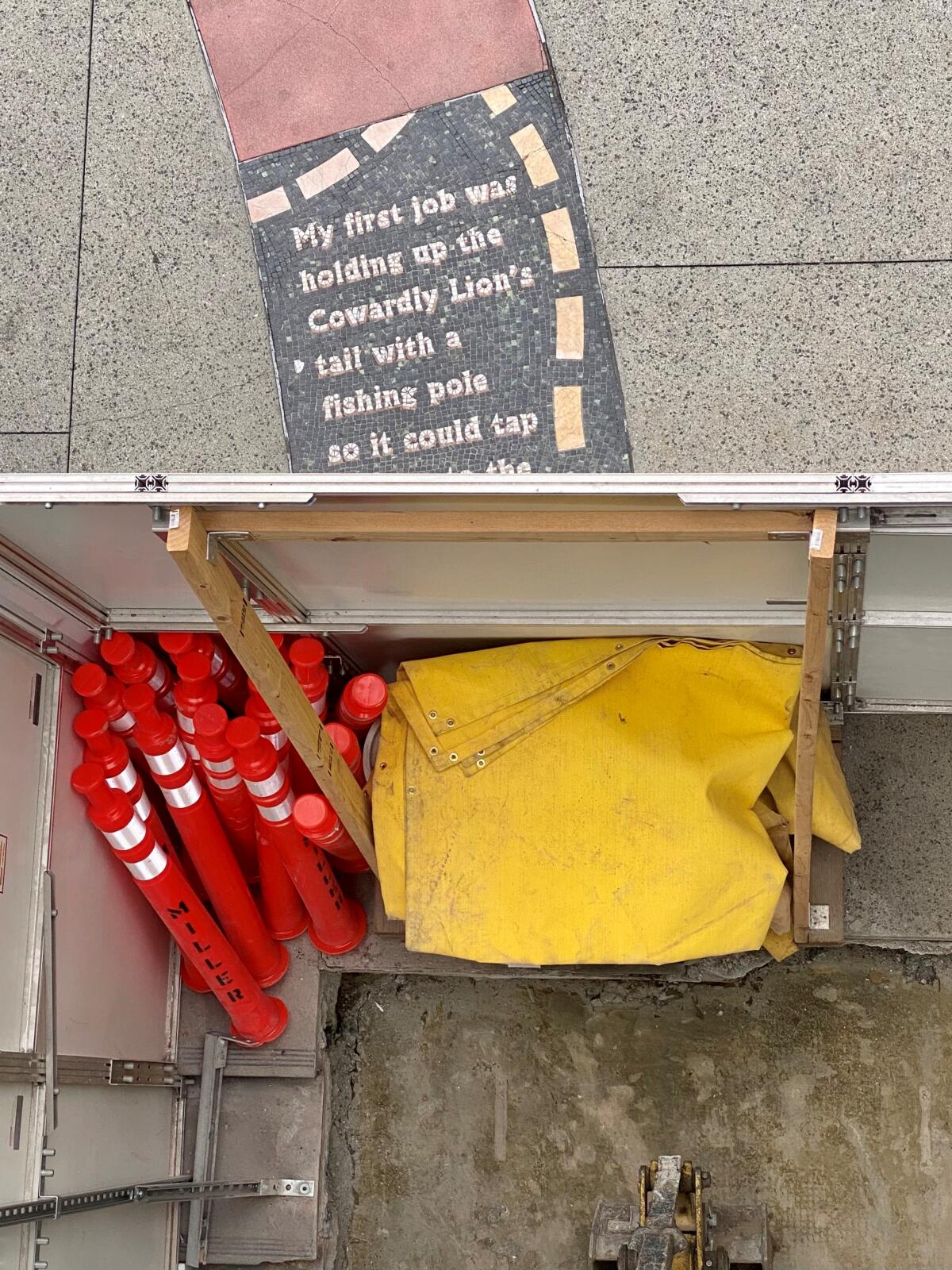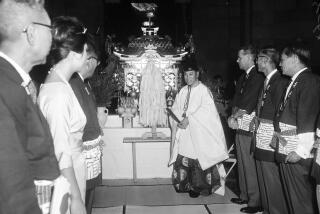Demolition begins on an acclaimed piece of L.A. public art

- Share via
A significant work of public art in Hollywood is being demolished in plain sight, and its creator can do little but watch.
Erika Rothenberg’s 2001 artwork “The Road to Hollywood” has long been embedded in the outdoor stairwells, walkways and plazas of the Hollywood & Highland development. Her winding concrete and mosaic pathway — called one of the best public art projects in L.A. by Times critic Christopher Knight when the center opened — is peppered with true stories of how successful Hollywood figures got their start in showbiz. The inspirational path leads to an upper deck with a view of the Hollywood sign where, in between a California Pizza Kitchen and a Shoe Palace, a large fiberglass daybed awaits wistful dreamers.
For 20 years, the artwork has lived under the feet of locals and selfie stick-wielding tourists, a prop in family vacation photos offering understated moments of humor and inspiration amid overstated retail homogeny.
The daybed remains, for now, but portions of “The Road to Hollywood” have already been jackhammered. According to Kristofer Golder, a senior development manager at DJM, the firm that bought Hollywood & Highland two years ago, demolition on the remainder of the artwork will “be commencing over the next few months in phases.”

Rothenberg’s work was commissioned through L.A.’s now-shuttered Community Redevelopment Agency and the original developers of Hollywood & Highland in fulfillment of the “percent for the arts” program, which requires private developers of projects valued at or above $500,000 to pay for public art on their property or pay a fee to a city arts fund.
According to the contract that Rothenberg signed when “The Road to Hollywood” was commissioned, ownership of the artwork is tied to ownership of the property. When DJM bought Hollywood & Highland from the CIM group, DJM assumed ownership of Rothenberg’s work.
Rothenberg does, however, have the right to remove “The Road to Hollywood” if an owner wants to get rid of it. In September 2020, DJM alerted Rothenberg about the demolition and gave her 90 days to remove the work.
“Yes, I have the right to remove it,” Rothenberg said. “But obviously, a person can’t really afford to do that. It should be preserved, even if it went into storage. It’s part of L.A. history. But whether or not that will happen — we haven’t completely given up yet — but it’s not looking good right now.”
Looking for an ally who could help remove and store the work, Rothenberg reached out to Hollywood Heritage President Brian Curran. In spring, Curran asked conservator Rosa Lowinger to investigate whether removal of the work’s large text-based mosaics would be possible.
Lowinger, who says she is a big fan of the work and is eager to see it preserved, arrived at the site with her team and power tools. They quickly discovered a relatively simple method for removing the mosaic sections.
“It’s totally removable and preservable. It’s easy, actually. And we wouldn’t have to do all 49 of the mosaics, we could pick and choose, do a random number depending on cost,” Lowinger said. She quoted Rothenberg about $5,000 to mobilize and remove one mosaic section, $9,000 to remove two, or about $40,000 to remove 10.
Funding the removal of the artwork is one hurdle. Another is what to do with such a huge piece once it is removed. When Curran asked about accessing funds from the Private Arts Development Fee Program, City Councilman Mitch O’Farrell’s office told him that to use the funds, the artwork needed a concrete plan to be reinstalled in a different public location in Hollywood. Curran hasn’t been able to find a suitable location for the work, and long-term storage of the mosaics presents its own financial and logistical challenges.
“We’re looking for allies, knights in shining armor to either come forward in terms of helping us fund the removal or come up with a plan to help us access the development art fees,” Curran said.
Curran said DJM has “been very cooperative and very happy to work with us. Not happy enough to pay for it, but happy to let us go about and figure out a way to salvage this.”
But in a phone interview with DJM representatives last week, Golder said “the window of opportunity” to save the artwork had passed. “DJM and Gaw Capital hired a professional architectural photographer and a historian to document and memorialize the artwork with a dedicated print-on-demand art book,” he said.
DJM is trying to take “an outdated, thematic shopping mall and transition it into something that reflects the taste level of today’s guests,” a spokesperson said. Renovations are structural and cosmetic, turning retail space into office space and replacing the plaza and deck with a landscaped area reminiscent of the lawns at the Grove in L.A. or the Americana at Brand in Glendale.
The developer noted that it had submitted a new public art program to the city’s Department of Cultural Affairs for review. The plans include a large-scale arch mural by Geoff McFetridge depicting people with lights and cameras on one side, and a crowd standing in applause on the other — both stretching upward, “to capture the feeling of the Hollywood dream.”
So one picture of the Hollywood dream will replace another.

For her part, Rothenberg is coming to terms with the fate of “The Road to Hollywood.”
“I don’t discount the idea that nothing lasts forever, but it is heartbreaking,” she said. “And to be honest, I’ve had days when I take it hard. I understand they bought it, they want to make it into something, but I think it’s such a shame they couldn’t keep these mosaics there, which are just an incredible thing to have in Hollywood. They could. They wouldn’t.”
For now, Rothenberg’s work still functions as interactive public art. On a recent weekend morning, a woman on the upper deck busily positioned four children on the daybed with two adults behind them, snapping photos of the group with the Hollywood sign in the background. Theirs could be some of the last photos taken with “The Road to Hollywood.”

More to Read
The biggest entertainment stories
Get our big stories about Hollywood, film, television, music, arts, culture and more right in your inbox as soon as they publish.
You may occasionally receive promotional content from the Los Angeles Times.










